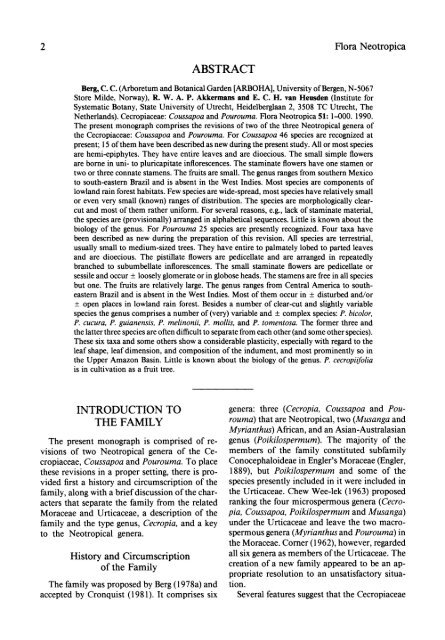Cecropiaceae: Coussapoa and Pourouma, with an ... - CNCFlora
Cecropiaceae: Coussapoa and Pourouma, with an ... - CNCFlora
Cecropiaceae: Coussapoa and Pourouma, with an ... - CNCFlora
You also want an ePaper? Increase the reach of your titles
YUMPU automatically turns print PDFs into web optimized ePapers that Google loves.
2 Flora Neotropica<br />
ABSTRACT<br />
Berg, C. C. (Arboretum <strong><strong>an</strong>d</strong> Bot<strong>an</strong>ical Garden [ARBOHA], University of Bergen, N-5067<br />
Store Milde, Norway), R. W. A. P. Akkerm<strong>an</strong>s <strong><strong>an</strong>d</strong> E. C. H. v<strong>an</strong> Heusden (Institute for<br />
Systematic Bot<strong>an</strong>y, State University of Utrecht, Heidelbergla<strong>an</strong> 2, 3508 TC Utrecht, The<br />
Netherl<strong><strong>an</strong>d</strong>s). <strong>Cecropiaceae</strong>: <strong>Coussapoa</strong> <strong><strong>an</strong>d</strong> <strong>Pourouma</strong>. Flora Neotropica 51: 1-000. 1990.<br />
The present monograph comprises the revisions of two of the three Neotropical genera of<br />
the <strong>Cecropiaceae</strong>: <strong>Coussapoa</strong> <strong><strong>an</strong>d</strong> <strong>Pourouma</strong>. For <strong>Coussapoa</strong> 46 species are recognized at<br />
present; 15 of them have been described as new during the present study. All or most species<br />
are hemi-epiphytes. They have entire leaves <strong><strong>an</strong>d</strong> are dioecious. The small simple flowers<br />
are borne in uni- to pluricapitate inflorescences. The staminate flowers have one stamen or<br />
two or three connate stamens. The fruits are small. The genus r<strong>an</strong>ges from southern Mexico<br />
to south-eastern Brazil <strong><strong>an</strong>d</strong> is absent in the West Indies. Most species are components of<br />
lowl<strong><strong>an</strong>d</strong> rain forest habitats. Few species are wide-spread, most species have relatively small<br />
or even very small (known) r<strong>an</strong>ges of distribution. The species are morphologically clearcut<br />
<strong><strong>an</strong>d</strong> most of them rather uniform. For several reasons, e.g., lack of staminate material,<br />
the species are (provisionally) arr<strong>an</strong>ged in alphabetical sequences. Little is known about the<br />
biology of the genus. For <strong>Pourouma</strong> 25 species are presently recognized. Four taxa have<br />
been described as new during the preparation of this revision. All species are terrestrial,<br />
usually small to medium-sized trees. They have entire to palmately lobed to parted leaves<br />
<strong><strong>an</strong>d</strong> are dioecious. The pistillate flowers are pedicellate <strong><strong>an</strong>d</strong> are arr<strong>an</strong>ged in repeatedly<br />
br<strong>an</strong>ched to subumbellate inflorescences. The small staminate flowers are pedicellate or<br />
sessile <strong><strong>an</strong>d</strong> occur + loosely glomerate or in globose heads. The stamens are free in all species<br />
but one. The fruits are relatively large. The genus r<strong>an</strong>ges from Central America to southeastern<br />
Brazil <strong><strong>an</strong>d</strong> is absent in the West Indies. Most of them occur in + disturbed <strong><strong>an</strong>d</strong>/or<br />
+ open places in lowl<strong><strong>an</strong>d</strong> rain forest. Besides a number of clear-cut <strong><strong>an</strong>d</strong> slightly variable<br />
species the genus comprises a number of (very) variable <strong><strong>an</strong>d</strong> + complex species: P. bicolor,<br />
P. cucura, P. gui<strong>an</strong>ensis, P. melinonii, P. mollis, <strong><strong>an</strong>d</strong> P. tomentosa. The former three <strong><strong>an</strong>d</strong><br />
the latter three species are often difficult to separate from each other (<strong><strong>an</strong>d</strong> some other species).<br />
These six taxa <strong><strong>an</strong>d</strong> some others show a considerable plasticity, especially <strong>with</strong> regard to the<br />
leaf shape, leaf dimension, <strong><strong>an</strong>d</strong> composition of the indument, <strong><strong>an</strong>d</strong> most prominently so in<br />
the Upper Amazon Basin. Little is known about the biology of the genus. P. cecropiifolia<br />
is in cultivation as a fruit tree.<br />
INTRODUCTION TO<br />
THE FAMILY<br />
The present monograph is comprised of re-<br />
visions of two Neotropical genera of the Ce-<br />
cropiaceae, <strong>Coussapoa</strong> <strong><strong>an</strong>d</strong> <strong>Pourouma</strong>. To place<br />
these revisions in a proper setting, there is pro-<br />
vided first a history <strong><strong>an</strong>d</strong> circumscription of the<br />
family, along <strong>with</strong> a brief discussion of the char-<br />
acters that separate the family from the related<br />
Moraceae <strong><strong>an</strong>d</strong> Urticaceae, a description of the<br />
family <strong><strong>an</strong>d</strong> the type genus, Cecropia, <strong><strong>an</strong>d</strong> a key<br />
to the Neotropical genera.<br />
History <strong><strong>an</strong>d</strong> Circumscription<br />
of the Family<br />
The family was proposed by Berg (1978a) <strong><strong>an</strong>d</strong><br />
accepted by Cronquist (1981). It comprises six<br />
genera: three (Cecropia, <strong>Coussapoa</strong> <strong><strong>an</strong>d</strong> <strong>Pourouma</strong>)<br />
that are Neotropical, two (Mus<strong>an</strong>ga <strong><strong>an</strong>d</strong><br />
Myri<strong>an</strong>thus) Afric<strong>an</strong>, <strong><strong>an</strong>d</strong> <strong>an</strong> Asi<strong>an</strong>-Australasi<strong>an</strong><br />
genus (Poikilospermum). The majority of the<br />
members of the family constituted subfamily<br />
Conocephaloideae in Engler's Moraceae (Engler,<br />
1889), but Poikilospermum <strong><strong>an</strong>d</strong> some of the<br />
species presently included in it were included in<br />
the Urticaceae. Chew Wee-lek (1963) proposed<br />
r<strong>an</strong>king the four microspermous genera (Cecropia,<br />
<strong>Coussapoa</strong>, Poikilospermum <strong><strong>an</strong>d</strong> Mus<strong>an</strong>ga)<br />
under the Urticaceae <strong><strong>an</strong>d</strong> leave the two macrospermous<br />
genera (Myri<strong>an</strong>thus <strong><strong>an</strong>d</strong> <strong>Pourouma</strong>) in<br />
the Moraceae. Corer (1962), however, regarded<br />
all six genera as members of the Urticaceae. The<br />
creation of a new family appeared to be <strong>an</strong> appropriate<br />
resolution to <strong>an</strong> unsatisfactory situation.<br />
Several features suggest that the <strong>Cecropiaceae</strong>
















